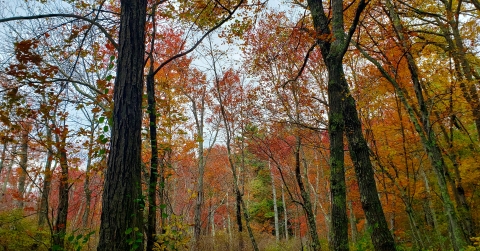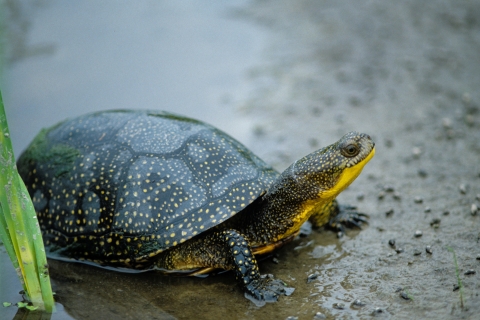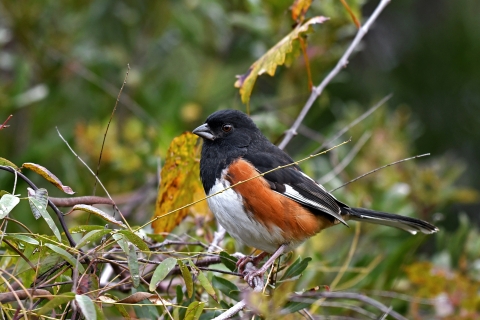
Spring 2025 turkey hunting season in the state of Massachusetts dates are:
Saturday, April 26th (Youth Hunt Day)
Monday, April 28th - Saturday, May 24th (Regular season)
Please remember that:
- Hunting is allowed within designated areas of the refuge
- It is recommended to wear blaze orange when recreating outdoors during hunting season
- Hunting is only allowed by permit, and with a valid Massachusetts hunting license
- There is no hunting allowed ANYWHERE in the state of Massachusetts on Sundays
Visit Us
Assabet River National Wildlife Refuge, close to Boston, is a local treasure. This former U.S. Army property is now a remarkable area to explore with over 15 miles of trails.
Location and Contact Information
- Assabet River National Wildlife Refuge (Headquarters for Eastern Massachusetts NWR Complex)
About Us
Assabet River National Wildlife Refuge is one of eight national wildlife refuges that comprise the Eastern Massachusetts National Wildlife Refuge Complex and serves as its headquarters. Over time these lands were traditionally hunted and fished by Nipmuc Tribes, farmed by colonists, crossed by railroad and used for military training. This area was known as the Sudbury Training Annex, part of Fort Devens and the U.S. Army until 2000 when the U.S. Army transferred over 2,000 acres to the U.S. Fish and Wildlife Service, therefore establishing the refuge.
Important habitat types on the refuge, such as freshwater wetlands, oak-pine forest, and shrubland are crucial in our management of migratory bird conservation. Many wildlife call Assabet River home including, numerous species of waterfowl and wading birds, songbirds, raptors, American beaver, bobcat, white-tailed deer, and various reptiles and amphibians.
What We Do
Wildlife conservation is at the heart of the National Wildlife Refuge System. It drives everything on U.S. Fish and Wildlife Service lands and waters managed within the Refuge System, from the purposes for which a national wildlife refuge national wildlife refuge
A national wildlife refuge is typically a contiguous area of land and water managed by the U.S. Fish and Wildlife Service for the conservation and, where appropriate, restoration of fish, wildlife and plant resources and their habitats for the benefit of present and future generations of Americans.
Learn more about national wildlife refuge is established to the recreational activities offered to the resource management tools used. Using conservation best practices, the Refuge System manages Service lands and waters to help ensure the survival of native wildlife species.
Assabet River National Wildlife Refuge uses an array of management tools to ensure the conservation of species and habitats and to keep visitors educated, protected, and most importantly appreciating nature. From combating invasive species invasive species
An invasive species is any plant or animal that has spread or been introduced into a new area where they are, or could, cause harm to the environment, economy, or human, animal, or plant health. Their unwelcome presence can destroy ecosystems and cost millions of dollars.
Learn more about invasive species and comprehensive conservation planning to recreation management and everything in between.
Our Species
The refuge helps conserve and protect wildlife and habitats surrounding the Sudbury-Assabet-Concord Rivers watershed. Special bird species the refuge manages for includes eastern towhee, grey catbird, scarlet tanager, Baltimore oriole, American woodcock, willow flycatcher, and the eastern kingbird. The Massachusetts' threatened Blanding's turtle is another important species that is managed for on the refuge. Biologists are partnering with researchers to establish a larger, diverse population at Assabet River National Wildlife Refuge. Protecting certain species' habitats not only enhance those populations, but supports all wildlife residing in that area, such as other birds including raptors, pollinating insects, reptiles, mammals, and vernal pool amphibians.
Projects and Research
Most research, projects, and initiatives on the refuges comprising the Eastern Massachusetts National Wildlife Refuge Complex examine management of avian resources, various public uses, rare, threatened, or endangered species and habitats, and invasive species invasive species
An invasive species is any plant or animal that has spread or been introduced into a new area where they are, or could, cause harm to the environment, economy, or human, animal, or plant health. Their unwelcome presence can destroy ecosystems and cost millions of dollars.
Learn more about invasive species control.





























